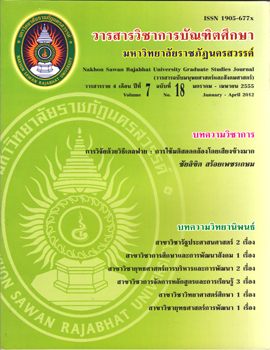การพัฒนากระบวนการพัฒนาครูโดยยึดสมรรถนะเป็นฐานของโรงเรียนสังกัด สำนักงานคณะกรรมการการศึกษาขั้นพื้นฐาน ในเขตภาคเหนือตอนบน
Main Article Content
Abstract
บทคัดย่อ
การวิจัยครั้งนี้มีวัตถุประสงค์เพื่อศึกษาสภาพปัญหาของกระบวนการพัฒนาครูโดยยึดสมรรถนะเป็นฐาน เพื่อพัฒนากระบวนการพัฒนาครูโดยยึดสมรรถนะเป็นฐาน และเพื่อตรวจสอบความเป็นไปได้ของกระบวนการพัฒนาครูโดยยึดสมรรถนะเป็นฐานของโรงเรียนสังกัดสำนักงานคณะกรรมการการศึกษาขั้นพื้นฐาน ในเขตภาคเหนือตอนบน ประชากรและกลุ่มตัวอย่าง ได้แก่ ครูต้นแบบ จำนวน 230 คน ได้มาจากการสุ่มแบบหลายขั้นตอน เครื่องมือที่ใช้ในการวิจัย ได้แก่ แบบสัมภาษณ์แบบสอบถามความคิดเห็นครูต้นแบบเกี่ยวกับความเป็นไปได้ของกระบวนการพัฒนาครูโดยยึดสมรรถนะ เป็นฐาน ในเขตภาคเหนือตอนบนโดยตรวจสอบความตรงของเนื้อหาและหาค่าความเที่ยงของแบบสอบถาม โดยวิธีสัมประสิทธิ์แอลฟา การวิเคราะห์ข้อมูลเชิงคุณภาพใช้การวิเคราะห์เชิงพรรณนาเกี่ยวกับสภาพปัญหาของกระบวนการพัฒนาครูโดยยึดสมรรถนะเป็นฐาน ส่วนการวิเคราะห์ข้อมูลเชิงปริมาณใช้สถิติเบื้องต้น โดยใช้โปรแกรมคอมพิวเตอร์สำเร็จรูป SPSS for Windows ด้วยการหาค่าเฉลี่ย ค่าร้อยละและค่าเบี่ยงเบนมาตรฐาน
ผลการวิจัยสรุปได้ดังนี้
1) สภาพปัญหาของกระบวนการพัฒนาครูโดยยึดสมรรถนะเป็นฐาน ในเขตภาคเหนือตอนบน มีปัญหา 4 ด้าน ได้แก่ ปัญหาด้านครู ด้านหลักสูตร ด้านนโยบาย และด้านสภาพแวดล้อม 2) กระบวนการพัฒนาครูโดยยึดสมรรถนะเป็นฐาน ในเขตภาคเหนือตอนบน จากการตรวจสอบความสอดคล้องเหมาะสมโดยผู้ทรงคุณวุฒิ มีความสอดคล้องเหมาะสมทั้ง 4 องค์ประกอบ ได้แก่ การกำหนดตัวแบบสมรรถนะ การประเมินสมรรถนะ การพัฒนาสมรรถนะ และการประเมินการพัฒนาสมรรถนะ และ 3) กระบวนการพัฒนาครูที่พัฒนาขึ้นพบว่า การกำหนดตัวแบบสมรรถนะ การประเมินสมรรถนะ การพัฒนาสมรรถนะและการประเมินการพัฒนาสมรรถนะของกระบวนการพัฒนาครูโดยยึดสมรรถนะเป็นฐานมีความเป็นไปได้ในระดับมาก โดยมีค่าเฉลี่ยเท่ากับ 4.19, 4.25, 4.49 และ 4.41 ตามลำดับ เมื่อพิจารณาในภาพรวมระดับความคิดเห็นเกี่ยวกับความเป็นไปได้ของกระบวนการพัฒนาครูโดยยึดสมรรถนะเป็นฐานอยู่ในระดับมาก มีค่าเฉลี่ยเท่ากับ 4.32
Abstract
The purposes of this research were to investigate the problems of the teacher’s development process using the competency-based approach, to develop the teacher’s development process using the competency-based approach and to examine the feasibility of the teacher’s development process using the competency-based approach of the schools under the office of Basic Education in the Upper Northern Region. The research population and sample were the 230 master teachers obtained from a multi-stage random sampling. The study employed three research tools: the in-depth interviews, the questionnaires were used to examine the consistency and the questionnaires were used to collect the data from master teachers about the feasibility of the improvement of the teacher’s development process using the competency-based approach in the Upper Northern Region. The feasibility of the content validity and reliability with alpha coefficient were done. The qualitative data analysis was used by the descriptive analysis method about the problems of the teacher’s development process using the competency-based approach. The analysis of quantitative data used the basic statistics to get the condition of samples and variables. The SPSS for Windows software package was used to calculate the average percent standard deviation.
The results of the study were concluded as follows:
1) In the development process based on the approach in the Upper Northern Region it was found that there were 4 problems: the teacher’s problem, the curriculum, the policy and the environment. 2) The teacher’s development process using the competency-based approach in the Upper Northern Region approved by the experts found that 4 elements were relevant such as the competency model, the competency assessment, the competency development and the competency monitoring assessment,and3)The teacher development process based on the competency-based approach as the results, the format of the competency model, competency assessment, competency development and the competency monitoring assessment in the process of teacher development based on the competency-based approach had enhanced the feasibility at the high level ( = 4.19 , 4.25 , 4.49 and 4.41). When considered as a whole it was found that the comments about the feasibility were at the high level ( = 4.32).

